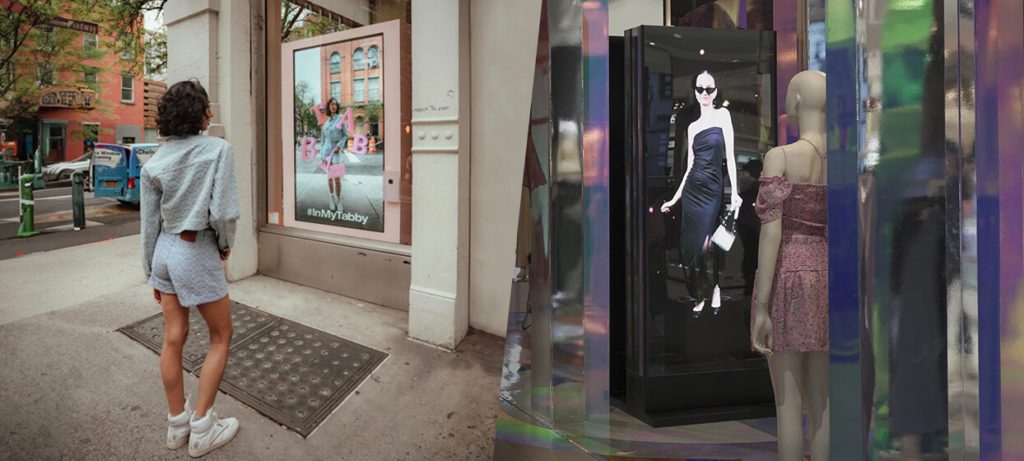
HYPERVSN 3D Catalog
USD 1,200
Qty

HYPERVSN 3D Catalog
USD 1,200
Qty

HYPERVSN 3D Catalog
USD 1,200
Qty
Cart Subtotal:
USD 3,600

Astrid Pocklington
Head of Demand Generation
The traditional high street is dead, at least that’s what we’ve been led to believe by the constant closures of some much beloved high street brand stores. But instead of witnessing the death of the high street, we’re seeing a rejuvenation of creativity, innovation and next-level customer engagement that has the potential to enliven the high street once more.
Welcome to the age of Phygital Technology, a transformative era where physical and digital elements merge together to form a seamless and futuristic experience for customers; from digital avatars to holographic models and store assistants, the creative opportunities with this technology are almost endless. Bringing together the convenience of the online experience with the dynamic immersion of making a physical purchase, this is a brand new phygital world for the high street, one where digital models and mannequins are redefining what it means to represent, immerse and engage with today’s public in the Retail sector, and bring our online and offline lives together for a truly elevated shopping experience.
This new phygital age of retail has brought with it innovation and creativity, and in particular has seen the rise of digital mannequins, 3D human avatars that are integrated into the design of physical stores to showcase products. Whether via digital mirrors, screens or even projectors, they provide customers with a new-age and engaging look at how clothes sit on the body, how beauty items look on the customer’s skin tone, give people the ability to customise outfits to their preferences, and even allow customers to see digital versions of themselves in the items they’re looking to purchase. Their integration into the retail experience is revolutionising how customers ‘try on’ clothing and beauty items, moving it from the rigid physical realm to the customisable virtual, enhancing how they engage and see themselves within a brand’s context, and dramatically influencing their purchasing decisions.
In-store, they are a powerful conversion tool that allows customers to immerse themselves into the look and feel they’re after, all without the previous stresses of actually trying on the products themselves. Beyond the store however, the streets are being brought to life with storefronts that are embracing this digital inclusion; vibrant and immersive digital window displays using 3D holographic mannequins to wow passersby and bring in huge numbers of fascinated potential customers. This isn’t just a new-age marketing tool, it’s a brand’s invitation to join them in this new virtual world of phygital inclusion and excitement. With 63% of shoppers wanting more interactive digital experiences while they shop, this innovative phygital technology is a common sense move for brands who want to keep up with the demands of today’s increasingly tech-savvy consumer, and bring a new, engaged and motivated buyer into their rejuvenated stores.
Look at Coach for instance, and their AR driven Tabby Bag campaign – happening in SoHo New York. They placed AR digital mirrors in their window displays and stopped passersby in their tracks as they became virtual models for the brand. Seeing themselves with fun and quirky digital designs, alongside the iconic Coach Tabby bag itself, enticed huge numbers into the store, eager to experience more of this new phygital technology, and allowed them to engage on social media with the hashtag ‘InMyTabby’ and their very own Coach/Tabby Bag adverts starring themselves. An incredibly savvy and switched on move from a brand that isn’t particularly known for their futurism, this engaged a much younger and more motivated audience in a simple and dynamic way.
Using this new and exciting 3D technology, brands are able to significantly elevate their high street stores from simply being product showcase spaces, turning them into brand experience centres that focus on creating a powerful connection between the brand and the consumer. Not only does this drive revenue, it dramatically improves consumer advocacy and loyalty, taking their brand awareness to dazzling new heights.
Virtual try-ons are key to this success, as by personalising the consumer’s experience directly to their preferences and shopping habits, people are much more likely to stay engaged and motivated by the brand for longer periods of time. Burberry for instance, the iconic British heritage brand, has been using AR-powered virtual try on technology for a while now, allowing customers to put themselves in the products they’re interested in purchasing, and even going a step farther and allowing them to adapt the size, fit and placement of the item on their digital bodies. This enhanced level of personalisation drives not only improved customer satisfaction but also increases the purchasing motivation, and even taps into the consumer’s social media habit by allowing them to share these AR-generated images to their social platforms, generating powerful UGC and the organic marketing that brands are looking for.
Driving sales is of course the priority for any business, but creating a dynamic and exciting experience for consumers is key to retaining their long-term interest. Falabella, the Peruvian clothing brand, worked with HYPERVSN partner SmartCorp Peru, to deploy several of these digital mannequin setups across their stores. This project was done to inject some futurism and tech innovation into the brand, but also add a touch of humanity to their stores leaving behind the faceless mannequins they used previously. The response they got from customers was brilliant, showing them that people wanted to see more of these interactive retail elements on their customer journey.
When it comes to the ‘why and wherefore’ of phygital marketing, we need to remember that consumer psychology is based on the premises of anticipated pleasure and pain, and a pleasurable customer experience equates to the individual making a purchase. The traditional faceless mannequin has a history of being seen as a problem for a large swathe of the purchasing public – reflecting neither the body shape or features customers want to see, namely their own features, it’s difficult for people to look at a mannequin and say ‘that’s for me’ unless you fit into the very niche tall and slender stereotype these mannequins were largely based on.
Now, with digital mannequins reflecting real-world humans with varying body types, ethnicities and features, and thanks to AR mirrors, virtual try-ons and such, it is much easier for people to relate and engage with their preferred products and therefore easier for them to see themselves in whatever they’re showcasing, be it fashion or beauty. The easier people can engage and see themselves in a product, the greater the attachment they feel for the product itself and the higher the likelihood of them making the purchase. At the end of the day, much like experiential marketing, the consumer isn’t there to learn about your brand or your service, they’re solely focused on the experience your products can provide them, and if they feel that they can see themselves living a life that is enhanced by your product, they will pay for that privilege.
While phygital elements in stores are definitely an eye-catching and fun feature, it’s the psychological power of attachment, pleasure and personalisation to the products that really makes the biggest differences to the consumer and their buying motivation.
Personalisation, engagement, innovation and creativity are the driving forces behind the power of phygital technology, and something that when done right, retail can benefit from in powerful ways. Initiatives like Burberry, Falabella, Coach and many more are showcasing the strength behind digital mannequins and immersive customer experiences, delivering potent associations and purchasing motivations that other retailers can only dream of.
Offering customers the chance to fully engage with their preferred products drives stronger attachments and an increased willingness to purchase. This transformation turns the historically one-size-fits-all retail experience into a revolutionary, customised journey centred around realism, interaction, personalisation and pleasure.
To drive sales, you need to prioritise putting your customers at the very heart of your retail experience, delivering an interactive and engaging journey that only phygital technology can provide.



subscribe

USD 1,200
Qty

USD 1,200
Qty

USD 1,200
Qty
Cart Subtotal:
USD 3,600☎️